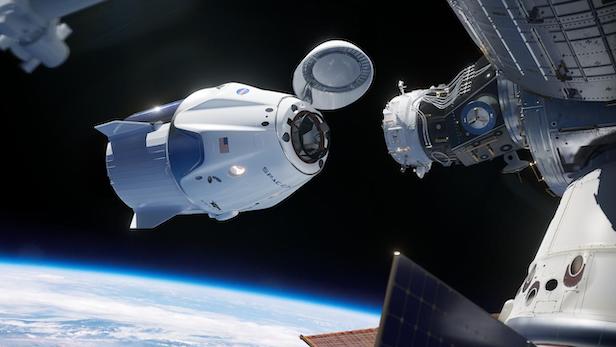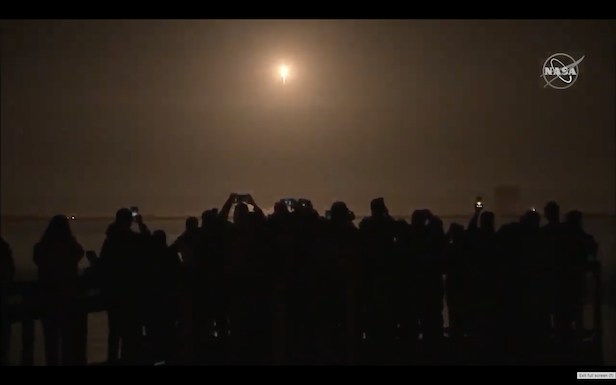SpaceX and NASA complete historic rendezvous with the ISS
Demo-1 marked an incredible collaborative effort between NASA and SpaceX that has shown positive signs of what’s to come

The SpaceX Crew Dragon is docked to the station’s international docking adapter which is attached to the forward end of the Harmony module. Image credit: SpaceX
For the first time in history, a commercially-built and operated American crew spacecraft and rocket, which launched from American soil, made its way to the International Space Station (ISS). The SpaceX Crew Dragon spacecraft lifted off at 7:49 a.m. GMT (2:49 a.m. EST) 2 March 2019 on the company’s Falcon 9 rocket from Launch Complex 39A at NASA’s Kennedy Space Centre in Florida, United States.
After making 18 orbits of Earth since its launch early Saturday morning, the Crew Dragon spacecraft successfully attached to the ISS’ Harmony module forward port via “soft capture” at 10:51 a.m. GMT (5:51 a.m. EST) on 3 March 2019 while the station was travelling more than 400 kilometres (250 miles) over the Pacific Ocean, just north of New Zealand.
“Today’s successful launch marks a new chapter in American excellence, getting us closer to once again flying American astronauts on American rockets from American soil,” says NASA Administrator Jim Bridenstine on 2 March 2019. “I proudly congratulate the SpaceX and NASA teams for this major milestone in our nation’s space history. This first launch of a space system designed for humans, and built and operated by a commercial company through a public-private partnership, is a revolutionary step on our path to get humans to the Moon, Mars and beyond.”
Known as Demo-1, SpaceX’s inaugural flight with NASA’s Commercial Crew Program is an important uncrewed mission designed to test the end-to-end capabilities of the new system. It brings the nation one-step closer to the return of human launches to the space station from the United States for the first time since 2011 – the last space shuttle mission. Teams still have work to do after this flight to prepare the spacecraft to fly astronauts. The best way to advance the system design was to fly this spacecraft and uncover any other areas or integrated flight changes that might be required.
The program demonstrates NASA’s commitment to investing in commercial companies through public-private partnerships and builds on the success of American companies, including SpaceX, already delivering cargo to the space station. Demo-1 is a critical step for NASA and SpaceX to demonstrate the ability to safely fly missions with NASA astronauts to the orbital laboratory.
“First a note of appreciation to the SpaceX team. It has been 17 years to get to this point, 2002 to now, and an incredible amount of hard work and sacrifice from a lot of people that got us to this point…I’d also like to express great appreciation for NASA,” says Elon Musk, CEO and lead designer at SpaceX. “SpaceX would not be here without NASA, without the incredible work that was done before SpaceX even started and without the support after SpaceX did start.”
The public-private partnership combines commercial companies’ unique, innovative approaches to human spaceflight and NASA’s decades-long experience in design, development and operations of a crew space system.
“We are watching history being made with the launch of the SpaceX Demo-1 mission,” says Steve Stich, launch manager and deputy manager of NASA’s Commercial Crew Program. “SpaceX and NASA teams have been working together for years, and now we are side-by-side in control rooms across the country for launch, in-orbit operations and, eventually, splashdown of the Crew Dragon right here off Florida’s coast.”
SpaceX controlled the launch of the Falcon 9 rocket from Kennedy’s Launch Control Centre Firing Room 4, the former space shuttle control room, which SpaceX has leased as its primary launch control centre. As Crew Dragon ascended into space, SpaceX commanded the Crew Dragon spacecraft from its mission control centre in Hawthorne, California, United States. NASA teams will monitor space station operations throughout the flight from Mission Control Centre at the agency’s Johnson Space Centre in Houston Texas, United States.
Teams in the space station mission centre at Johnson monitored station crew members’ opening of the spacecraft hatch, entering Crew Dragon and unpacking the capsule.

Crowd gathers to watch as NASA and SpaceX make history by launching the first commercially-built and operated American crew spacecraft and rocket to the ISS. Image credit: NASA
All the launch pad and vehicle hardware, and the launch day operations, were conducted in preparation for the next flight with crew aboard, including the control teams and ground crews.
During the spacecraft’s approach, in-orbit demonstrations included rendezvous activities from a distance of up to four kilometres (2.5 miles), known as far field, and activities within 1.6 kilometres (one mile), known as near field. As the spacecraft approached the space station, it demonstrated its automated control and manoeuvring capabilities by reversing course and backing away from the station before the final docking sequence.
The docking phase, as well as the return and recovery of Crew Dragon, include many first-time events that cannot be totally modelled on the ground and, thus, are critical to understanding the design and systems ability to support crew flights. Previous cargo Dragon vehicles have been attached to the space station after capture by the station’s robotic arm. The Crew Dragon approached to dock using new sensor systems, new propulsion systems and the new international docking mechanism attached to the station’s Harmony module forward port, fitted with a new international docking adapter. Astronauts installed the adapter during a spacewalk in August 2016, following its delivery to the station in the trunk of a SpaceX Dragon spacecraft on its ninth commercial resupply services mission.
For Demo-1, Crew Dragon is carrying more than 180 kilograms (400 pounds) of crew supplies and equipment to the space station and will return some critical research samples to Earth. A lifelike test device named Ripley also will travel on the Crew Dragon, outfitted with sensors to provide data on potential effects on humans travelling in Crew Dragon.
For operational missions, Crew Dragon will be able to launch as many as four crew members and carry more than 100 kilograms (220 pounds) of cargo, enabling the expansion of the crew members, increasing the time dedicated to research in the unique microgravity environment, and returning more science back to Earth.
The Crew Dragon is designed to stay docked to station for up to 210 days, although the Crew Dragon used for this flight test will not have that capability. This spacecraft will remain docked to the space station only five days, departing Friday, March 8. After undocking from the station, Crew Dragon will begin its descent to Earth. Live coverage of the undocking will air on NASA Television and the agency’s website beginning at 7 a.m. GMT (2 a.m. EST), with deorbit and landing coverage resuming at 12:30 p.m. GMT (7:30 a.m EST).
Additional spacecraft mission objectives include a safe departure from the station, followed by a deorbit burn and parachute deployment to slow the spacecraft before splashdown in the Atlantic Ocean, off the Florida Space Coast. SpaceX’s recovery ship, Go Searcher, will retrieve Crew Dragon and transport it back to port. Teams will be closely monitoring the parachute system and entry control system operation, which have been changed from cargo Dragons to provide higher reliability for crew flights.
NASA and SpaceX will use data from Demo-1, along with planned upgrades and additional qualification testing, to further prepare for Demo-2, the crewed flight test that will carry NASA astronauts Bob Behnken and Doug Hurley to the International Space Station. NASA will validate the performance of SpaceX’s systems before putting crew on board for the Demo-2 flight, currently targeted for July 2019.
NASA’s Commercial Crew Program is working with Boeing and SpaceX to design, build, test and operate safe, reliable and cost-effective human transportation systems to low-Earth orbit. Both companies are focused on test missions, including abort system demonstrations and crew flight tests, ahead of regularly flying crew missions to the space station. Both companies’ crewed flights will be the first times in history NASA has sent astronauts to space on systems owned, built, tested and operated by private companies.
Keep up to date with the latest news in All About Space – available every month for just £4.99. Alternatively you can subscribe here for a fraction of the price!




